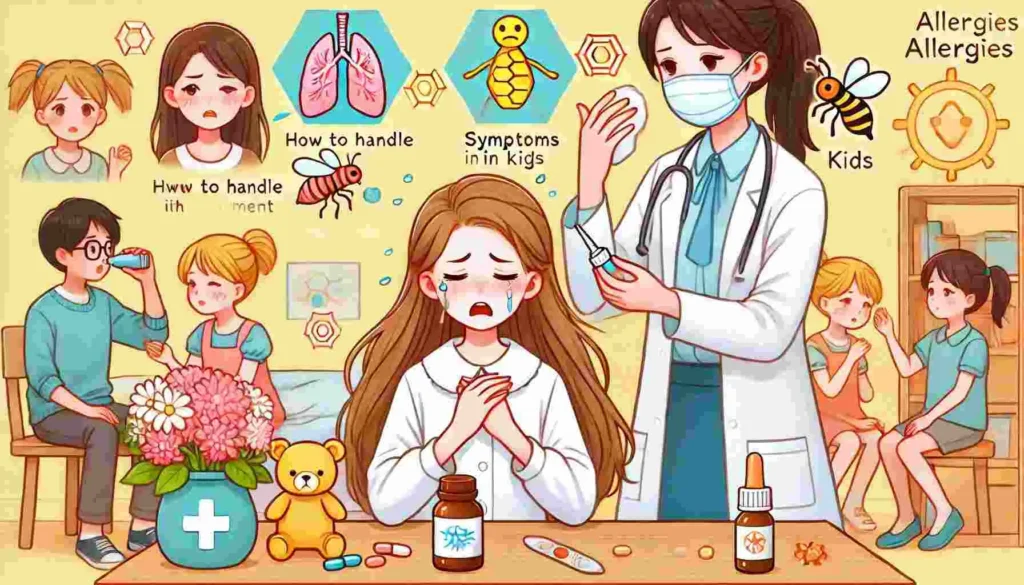
How to Handle Allergies in Kids: Symptoms and Management
Understanding Allergies in Children
What Are Allergies?
Allergies occur when the immune system reacts abnormally to harmless substances, such as pollen, pet dander, or certain foods. These substances, known as allergens, can trigger a range of symptoms that vary in intensity.
Common Allergens in Children
- Environmental Allergens:
- Pollen (trees, grasses, and weeds)
- Dust mites
- Mold spores
- Pet dander
- Food Allergens:
- Milk
- Eggs
- Peanuts
- Tree nuts
- Shellfish
- Soy
- Wheat
- Other Allergens:
- Insect stings
- Medications
- Latex
Recognizing Allergy Symptoms
Mild Allergy Symptoms
- Sneezing
- Runny or stuffy nose
- Itchy, watery eyes
- Skin rash or hives
- Mild abdominal discomfort
Moderate to Severe Symptoms
- Difficulty breathing
- Swelling of the lips, tongue, or face
- Persistent vomiting or diarrhea
- Wheezing or coughing
- Anaphylaxis: A life-threatening allergic reaction that requires immediate medical attention.
Seasonal Allergies
Children with seasonal allergies, also known as hay fever or allergic rhinitis, may experience:
- Sneezing and nasal congestion
- Itchy throat and ears
- Fatigue due to poor sleep quality
Diagnosing Allergies in Kids
1. Observation and History
Parents can play a vital role in identifying allergies by observing their child’s symptoms and potential triggers. Keeping a symptom diary can help pinpoint patterns.
2. Allergy Testing
- Skin Prick Test: A small amount of allergen is introduced under the skin to check for a reaction.
- Blood Tests: Measures the immune system’s response to specific allergens.
- Elimination Diets: Used to identify food allergies by removing and reintroducing potential allergens under medical supervision.
3. Consulting a Specialist
A pediatric allergist can provide expert advice and a tailored management plan for your child’s allergies.
Management Strategies for Allergies in Kids
1. Avoiding Triggers
- Environmental Allergies:
- Keep windows closed during high pollen seasons.
- Use air purifiers to reduce indoor allergens.
- Wash bedding and soft toys regularly to minimize dust mites.
- Food Allergies:
- Read food labels carefully to avoid allergens.
- Teach your child about safe and unsafe foods.
- Communicate your child’s allergies to teachers and caregivers.
2. Medications
- Antihistamines: Relieve mild to moderate symptoms such as itching and sneezing.
- Nasal Sprays: Reduce inflammation in nasal passages for seasonal allergies.
- Epinephrine Auto-Injectors: Essential for children at risk of anaphylaxis. Always have it on hand.
3. Immunotherapy
For persistent allergies, immunotherapy (allergy shots or tablets) can help desensitize the immune system over time, reducing the severity of reactions.
Home Remedies for Managing Allergies
While professional medical advice is essential for severe allergies, some home remedies can complement allergy management for mild to moderate symptoms.
1. Saline Nasal Rinses
Saline rinses help clear nasal passages of allergens like pollen, dust, and pet dander. They can be used daily during allergy season to reduce congestion and irritation.
- How to Use:
- Use a child-friendly saline spray or rinse.
- Ensure your child tilts their head slightly and gently sprays into each nostril.
2. Honey (for Seasonal Allergies)
Local raw honey may help build immunity to pollen. Though research is limited, many parents find this remedy useful.
- Note: Do not give honey to children under 1 year old due to the risk of botulism.
3. Steam Inhalation
Steam helps open nasal passages and relieve congestion caused by environmental allergies.
- How to Use:
- Fill a bowl with hot water.
- Have your child inhale the steam with a towel over their head (under supervision).
4. Cold Compress for Itchy Eyes
Cold compresses can soothe itchy, puffy eyes caused by allergens like pollen or pet dander.
- How to Use:
- Soak a clean cloth in cold water.
- Place it gently over your child’s eyes for 5-10 minutes.
Lifestyle Adjustments for Allergy Management
1. Create an Allergy-Free Home Environment
Minimizing allergens at home is crucial for managing symptoms. Here’s how to create a safer space:
- Regular Cleaning:
- Vacuum carpets and rugs frequently using a HEPA filter vacuum.
- Dust surfaces with damp cloths to prevent allergens from becoming airborne.
- Pet Care:
- Bathe pets regularly to reduce dander.
- Keep pets out of your child’s bedroom.
- Reduce Mold:
- Use dehumidifiers to keep humidity below 50%.
- Clean bathrooms and kitchens frequently to prevent mold growth.
2. Improve Indoor Air Quality
Good air quality helps reduce exposure to allergens:
- Use Air Purifiers: Choose air purifiers with HEPA filters for bedrooms and living spaces.
- Maintain Proper Ventilation: Open windows when pollen counts are low and use exhaust fans to remove indoor pollutants.
3. Laundry Practices
- Wash Bedding Weekly: Use hot water to eliminate dust mites.
- Avoid Line-Drying Outdoors: Pollen can cling to clothes. Dry clothes indoors during allergy season.
School and Social Life: Supporting Your Child
1. Inform Teachers and Caregivers
Ensure that teachers, school staff, and caregivers are aware of your child’s allergies and know how to respond in case of an allergic reaction.
- Create an Allergy Action Plan: This should include:
- List of allergens to avoid.
- Symptoms to watch for.
- Emergency contact information.
- Instructions for administering medications like antihistamines or an epinephrine auto-injector.
2. Allergy-Friendly Lunches and Snacks
Pack allergy-safe foods for school to avoid potential exposure to allergens.
- Tips:
- Use clear labels for all containers.
- Teach your child to avoid food sharing.
3. Encourage Open Communication
Help your child feel comfortable discussing their allergies with peers and adults.
- Role-Playing: Practice scenarios where your child needs to explain their allergy or refuse a food they are unsure about.
- Confidence Building: Reinforce that managing allergies is about staying safe and healthy, not about being different.
Traveling with a Child Who Has Allergies
Traveling requires extra precautions to keep your child safe.
1. Plan Ahead
- Research Accommodations: Look for allergy-friendly hotels or rentals.
- Carry an Allergy Kit: Include antihistamines, epinephrine auto-injectors, and copies of your child’s allergy action plan.
2. Air Travel Precautions
- Inform the Airline: Notify airlines of food allergies in advance and ask about their allergy policies.
- Pack Safe Snacks: Bring allergy-safe food to avoid potential in-flight allergens.
3. Outdoor Activities
- Check Pollen Forecasts: Plan outdoor activities when pollen counts are low.
- Dress Appropriately: Have your child wear sunglasses and hats to minimize pollen exposure.
Creating an Allergy-Safe Environment
1. Allergy-Proofing Your Home
Your home should be a sanctuary where allergens are minimized. Here are specific tips for key areas:
- Living Room:
- Use leather or vinyl furniture instead of fabric to reduce dust mites.
- Keep pets off furniture and use washable throws.
- Bedroom:
- Use allergen-proof mattress and pillow covers.
- Wash bedding weekly in hot water (at least 130°F or 54°C).
- Remove stuffed animals or wash them frequently.
- Kitchen:
- Regularly clean countertops and cupboards to avoid cross-contamination.
- Store allergen-free foods in separate, labeled containers.
- Bathroom:
- Install exhaust fans to prevent mold growth.
- Clean tiles and shower curtains regularly to avoid mold build-up.
2. Keeping Indoor Air Quality High
Good air quality helps reduce exposure to common allergens like pollen, dust mites, and pet dander:
- HEPA Filters: Use HEPA air purifiers in common areas and bedrooms.
- Dehumidifiers: Maintain humidity levels below 50% to prevent mold growth.
- Ventilation: Open windows when pollen counts are low and use exhaust fans to remove indoor pollutants.
3. Allergy-Free Play Spaces
Create play areas that are safe and free from allergens:
- Avoid Carpets: Opt for hardwood or vinyl flooring that’s easier to clean.
- Washable Toys: Choose toys that can be washed regularly to eliminate dust and allergens.
- Pet-Free Zones: Designate certain rooms as pet-free to minimize exposure.
Navigating Allergies in Public Spaces
1. Safe School Environment
Collaborate with your child’s school to create a safe and supportive learning environment:
- Allergy Action Plan: Provide the school with a detailed plan outlining your child’s allergens, symptoms, and emergency procedures.
- Classroom Rules: Request allergen-free classrooms or designated allergen-free zones.
- Emergency Preparedness: Ensure teachers know how to use an epinephrine auto-injector and recognize severe allergic reactions.
2. Dining Out with Allergies
Eating out can be challenging for kids with allergies, but it can be managed with careful planning:
- Research Restaurants: Choose places that are known for accommodating food allergies.
- Communicate Clearly: Inform the server about your child’s allergies and ask about kitchen practices to avoid cross-contamination.
- Bring a Backup: Always have safe snacks or meals on hand in case of limited options.
3. Traveling Safely
Whether you’re traveling by car, plane, or train, preparation is key:
- Pack an Allergy Kit: Include medications, epinephrine auto-injectors, and copies of your allergy action plan.
- Plan Meals: Pack allergy-safe foods and snacks for the journey.
- Check Accommodations: Book allergy-friendly hotels and notify them of your child’s needs in advance.
Supporting Your Child’s Emotional Well-Being
1. Educating Your Child About Allergies
Knowledge is empowering. Teach your child about their allergies in an age-appropriate way:
- Explain Allergens: Help them understand what triggers their allergies and why it’s important to avoid them.
- Practice Scenarios: Role-play situations where they may need to refuse food or explain their allergies to others.
2. Building Confidence
Help your child feel confident in managing their allergies:
- Praise Independence: Celebrate when they remember to carry their allergy kit or check food labels.
- Encourage Self-Advocacy: Teach them to speak up about their needs without fear or embarrassment.
3. Emotional Support
Allergies can be stressful for children, leading to feelings of isolation or anxiety. Offer consistent support:
- Validate Their Feelings: Acknowledge their frustrations and reassure them that it’s okay to feel different.
- Connect with Other Kids: Join allergy support groups where your child can meet peers facing similar challenges.
Building a Support Network
1. Family and Friends
Educate close friends and family members about your child’s allergies:
- Allergy Awareness: Make sure they know which allergens to avoid and how to handle emergencies.
- Safe Gatherings: Plan allergy-friendly meals and activities during family events.
2. Support Groups
Connecting with other parents dealing with allergies can provide valuable insights and emotional support:
- Online Communities: Join allergy-focused forums and social media groups for tips and advice.
- Local Meetups: Attend events or workshops to build a local network of support.
3. Healthcare Providers
Regular communication with your child’s healthcare team is essential:
- Regular Check-Ups: Schedule routine visits with an allergist to monitor your child’s condition.
- Emergency Plan Reviews: Update the allergy action plan as needed to reflect any changes in symptoms or medications.
Preparing for the Future
1. Monitoring Allergy Progression
Some children outgrow certain allergies, while others may develop new ones. Stay vigilant by:
- Tracking Symptoms: Maintain a diary to note any changes or patterns in your child’s reactions.
- Retesting: Periodic allergy tests can determine if your child has outgrown specific allergies.
2. Teaching Lifelong Allergy Management
As your child grows, help them take responsibility for managing their allergies:
- Teenage Years: Teach them how to navigate social situations, dating, and traveling independently with allergies.
- Adulthood Preparation: Ensure they know how to refill prescriptions, recognize symptoms, and respond to severe reactions.



